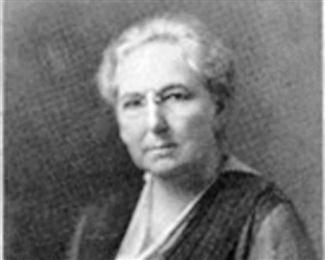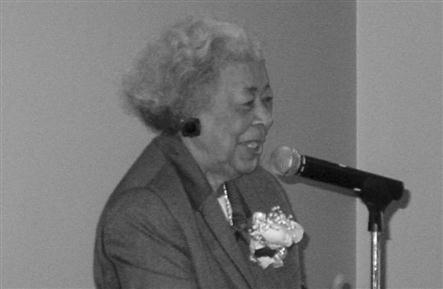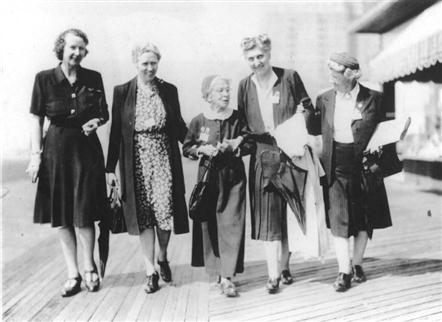A Historical Perspective on Policy, Politics, and Nursing
Sandra B. Lewenson
“Organization is the power of the age.”
—Sophia Palmer, founding editor of the American Journal of Nursing
The history of the modern nursing movement, which began in 1873, tells the story of a pioneering group of women who responded to the changing role of women in society. They advocated a new profession for women and better health care for the public. In forging the nursing profession in this modern period, nurses had to enter the political arena to gain legitimate authority over their education and practice.
Over time, however, the history has blurred and often obscured from view the rich tapestry of nursing’s political past. This can be explained in part by the fact that women are perceived by society to have historically played a small role in the political arena. Nursing, long considered “women’s work,” shares with the overall women’s movement the many negative, devalued perceptions of the worth of its role (Reverby, 1987). The assumption that women’s work is somehow free and expected perpetuates the negative aspects of “nursism”—“a form of sexism that specifically maligns the caring role in society” (Lewenson, 1996, p. 226).
The history of nursing is replete with stories of nurses’ activism to advance the profession and health care, and this chapter provides some examples.
Political Awakening and the Modern Nursing Movement
The modern nursing movement began when Florence Nightingale opened the nurse-training program at St. Thomas Hospital in England in 1860. This landmark event signaled to the world that nurses required schooling for the work they did and provided one of the first opportunities for women to work outside the home and be self-supportive. In turn, the rise of modern nursing catalyzed the political activism of nurses.
Nightingale’s writing supports a feminist stance on who should control the education and work of nurses. Nightingale believed that nursing should be controlled by nurses. A 1908 editorial comment published in the American Journal of Nursing (AJN) acknowledged that her “brilliant essence lay in her taking from men’s hands a power which did not logically or rightly belong to them, but which they had usurped, and seizing it firmly in her own, from whence she passed it on to her pupils and disciples” (Progress and reaction, 1908, pp. 333-334). Like women’s education, education for nurses was considered unnecessary. Women were considered natural-born nurses and therefore did not require an education. After the extraordinary success of Nightingale’s ideas about sanitation and nurses’ education, nurses were educated to reform the deplorable conditions found in hospitals throughout the United States.
Nightingale, the reformer, emerges as a complex individual who often achieved her goals “by behind-the-scenes management of the committees and doctors” (Vicinus & Nergaard, 1989, p. 159). It was her letter-writing to influential people that helped Nightingale revolutionize health care and nursing education. Moreover, it was the acceptance, around the world, of her ideas about sanitation, education, and separation of nursing and medicine that contributed to her ability to facilitate change.
Professional Education and Nurse-Training Schools
Political activism of the early nursing pioneers took the form of creating the models for professional education. The year 1873 heralded the opening of Nightingale-influenced nurse-training schools and the beginning of the modern nursing movement in the United States. Early nursing leaders implemented many of Nightingale’s ideas about nursing. They skillfully demonstrated to hospital administrators that using nursing students improved sanitary conditions on wards and led to better patient outcomes, creating great financial incentives for hospitals to open such schools (Dock & Stewart, 1931). Between 1873 and 1893, nurse-training schools proliferated, and by 1910 the number of schools had risen to more than 1129 (Burgess, 1928). But these early schools were not regulated by any professional group. Hospital administrators wanted these schools because it was cheaper to use student labor than to employ the graduates—education was secondary to work expected of the students.
Once a nurse’s training was over, the school provided no support. Graduate nurses found themselves working in the only jobs they could find, such as private duty nursing or public health nursing. Physicians or pharmacists, as opposed to nurses, often controlled the private duty nursing directories, which distributed private duty work. This meant that the fee schedule rested outside the nurses’ control, which often led to further exploitation of an already exploited group. The misuse of both the students and the graduate nurses contributed greatly to the strong political stance that early nursing leaders took when they formed professional nursing organizations.
Political Action and the Rise of Professional Organizations
Professional nursing organizations began to form between 1893 and 1912. Their interests first revolved around the issues confronting the profession but later expanded to include social and political reforms affecting society.
National League for Nursing
The first national nursing organization to form was the American Society of Superintendents for Training Schools, founded in 1893 and renamed the National League of Nursing Education in 1912 and the National League for Nurses (NLN) in 1952. This organization originated at the nurses’ congress that convened at the World’s Columbian Exposition in Chicago in 1893. Superintendents, chief administrators, and hospital nursing staff sought uniformity in nursing curricula and standards of nursing practice. Alone in their work, they felt isolated and powerless to go before the entrenched powers, such as the hospital boards and medical groups, that sought to control the developing profession. The early speeches of leaders such as Isabel Hampton Robb, Lavinia Dock, and Sophia Palmer spoke out in favor of collective action and reflected the progressive nature of the newly founded organization (Birnbach & Lewenson, 1993).
American Nurses Association
Training schools soon formed alumnae associations that would provide the basic structure for a second national nursing organization—the Nurses’ Associated Alumnae of the United States and Canada in 1896 (renamed the American Nurses Association [ANA] in 1911). Isabel Hampton Robb was one of the founders and first president of the organization. She advocated nursing reforms that supported the ideas of the emerging nursing profession, such as moving toward an 8-hour workday versus a 12-hour workday and efforts to obtain nursing registration.
Considering “journalism … to be a necessary part of the trend of nursing progress” (The Editor, 1900, p. 65) the organization founded the American Journal of Nursing (AJN), one of the first professional journals in nursing. Sophia Palmer, the first editor-in-chief of the AJN used the journal to call for a grassroots movement that would unite alumnae associations around the country for the purpose of political action and social reform (Figure 2-1). She urged small and large schools to organize alumnae associations “for the definite and separate purpose of promoting legislation for state registration of nurses” (Palmer, 1909, p. 956). She recognized the inherent power that nurses would wield, if they were united in a national organization. Palmer (1897) said, “Organization is the power of the age. Without it nothing great is accomplished. All questions having ultimate advancement of the profession are dependent upon united action for success” (p. 55).
The state alumnae associations organized around the highly political issue of state registration. Until 1903, anyone could call herself a nurse. It was not until 1903 that the first state nurse registration acts were passed and the title nurse was protected by law. Although the early registration acts varied in their protection of the public from inadequately prepared nurses, they signified the political efforts of organized nursing. Since nursing leaders did not yet have the vote, support for this legislation was gained through letter-writing campaigns, personal visits to the legislatures, use of the professional journals, and support of the public press.
National Association of Colored Graduate Nurses
Discriminatory practices in parts of the United States barred many African-American nurses from membership in their state associations. This practice in turn prevented them from belonging to the ANA. Moreover, segregation and discriminatory practices throughout the country banned African-American nurses from attending most nurse-training schools and, in some states, prohibited them from taking state nurse registration examinations. In keeping with other women’s organizations and the need for political activism, African-American nurses organized the National Association of Colored Graduate Nurses (NACGN) in 1908. Along with issues of blatant racial discrimination, the NACGN focused on education, standards of practice, and the passage of state nurse registration acts (Figure 2-2) (Staupers, 1937).
To determine the need for such an organization, Martha Franklin, nursing leader and founder of the NACGN, had undertaken a study on African-American nurses in 1906 and 1907. Franklin sent more than 1500 surveys to African-American graduates of nurse-training schools, most of which had opened in historically African-American hospital settings (Thoms, 1929), and found that African-American nurses needed an organization to address issues pertaining to their particular needs. Franklin also recognized that only in the collective would they gain enough power to change discriminatory practices and influence nursing and health care (Lewenson, 1996).
Members of the NACGN constantly faced the double-edged sword of sexism and racism, which led to their political activism. A primary concern for the NACGN was the nurse registration acts that the profession as a whole sought. Not only did the organization support the passage of such acts, but its members also fought to ensure that nurses of color could sit for the state examination and be given the same examination as their white counterparts.
The collective action of the NACGN around the issue of racial discrimination toward African-American nurses in the military during World War II serves as another example of political activism in nursing. Not until after the armistice in World War I were African-American nurses accepted into the Army Nurse Corps. It wasn’t until after a great political campaign waged by the NACGN during World War II that they were integrated into the armed services, albeit in limited numbers. Mabel Staupers, considered one of the people instrumental in the integration of African-American nurses into the military, prepared the NACGN to engage in the political effort needed to effect change (Hine, 1993). Staupers not only mobilized the NACGN but also sought the “allegiance of sympathetic white nurses within the profession” (Hine, 1989, p. 170). The NACGN used letter-writing campaigns, alliances with the other professional nursing organizations, membership in the newly established National Nursing Council for War Service, meetings with politically significant people, and collective action to integrate nursing in the military.
National Organization for Public Health Nursing
At the beginning of the twentieth century, the need for public health nurses increased as the U.S. experienced the effects of urbanization, industrialization, and immigration. Cities filled with people who wanted to find jobs in these growing industrialized centers. This change in demographics contributed to severely overcrowded housing, unsafe work conditions, inadequate sanitation, epidemics, and poor access to health care, causing progressive reformers to respond. The public health movement used trained nurses in public health departments and visiting nurse service agencies to bring their ideas about sanitation, immunization, and health care to the public. In 1902, there were fewer than 200 public health nurses; by 1912, there were more than 3000 (Gardner, 1933). With this steady proliferation of visiting nurse associations came unscrupulous home health care agencies that offered substandard visiting nurse services. To overcome poor and inferior nursing practices, the ANA and the NLN exerted their political expertise and in 1912 formed the National Organization for Public Health Nursing (NOPHN). This organization’s members joined with other civic-minded citizens to improve the health of the American public.
To create the NOPHN, in 1911 nursing leaders of the ANA and the NLN developed a plan to organize public health nurses. Letters sent to organizations that employed public health nurses requested that they send a representative to the annual nursing convention of the ANA and the NLN who could vote on the issue of starting a new organization. Most of the agencies responded favorably, and one year later, in 1912, the NOPHN organized. The NOPHN objectives were to “stimulate responsibility for the health of the community by the establishment and the extension of public health nursing” and “to develop standards and techniques in public health nursing service” (Gardner, 1933, p. 27). From the outset, the NOPHN recognized the political expediency of forming coalitions with other health professionals and laypeople and included these other individuals as members.
Organized Nursing and Suffrage
While the four nursing organizations were forming, the campaign for suffrage was under way. Suffrage meant personal and political freedom and the means to control the laws that governed women. For nurses, suffrage meant gaining a political voice in the laws that regulated practice, education, and health. Professional nursing organizations provided the medium for nurses to share common experiences and thus find a collective voice. Once these organizations established themselves as viable associations, nurses expanded their horizons to include broader women’s issues, including suffrage, in their political agenda (Lewenson, 1996). This period of political activism in nursing fits the description by Cohen and colleagues (1996) of the early stages of political development. Nursing, through the four organizations, had developed its identity, formed coalitions, built on its political base, and used the language needed for changing legislation. By advocating for patient rights, nurses began to shape policy. As nursing struggled to come to consensus over the issue of woman suffrage, they published a journal, formed coalitions among themselves and with non-nursing groups, and discussed the political ramifications of both sides of the suffrage question. Within the pages of the AJN, nurses had the opportunity to express their views on nursing’s support of woman suffrage. Although many nurses wanted to maintain the status quo and sought to avoid confrontational political battles, a sufficient number of nurses ardently believed that the survival of the profession rested on gaining suffrage.
Organized nursing’s efforts to support the political agenda of the international nursing community led to the formation of the American Federation of Nurses (AFN) between 1901 and 1912. This newly created federation, a coalition forged between the ANA and the NLN, enabled organized nurses in the U.S. to join the National Council of Women and thus become members of the International Council of Women and later the International Council of Nurses (ICN) (Lewenson, 1996). It is significant to note that by 1901, nursing in the U.S. was ready to form strong coalitions with other nursing groups both domestically and abroad. Nurse organizations gained a political voice in international health issues affecting women and were specifically interested in supporting suffrage (Figure 2-3).
Stay updated, free articles. Join our Telegram channel

Full access? Get Clinical Tree





